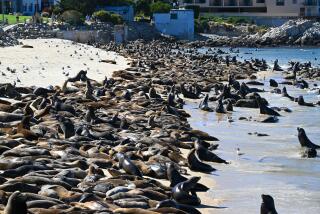Islandsâ Foxes Are Now Protected
SANTA CRUZ ISLAND -- Minutes after federal officials announced Thursday that the animal would be protected under the Endangered Species Act, a baby Channel Islands fox scampered across its pen, flopped onto a small hammock and dozed off.
The much-anticipated announcement was no big deal for the grayish, housecat-sized fox, but it marked a major step for scientists, conservationists and park officials desperately trying to save a creature that is nearly extinct. About 75 foxes roam Santa Cruz Island -- down from about 1,500 a decade ago.
After years of campaigning by conservationists, U.S. Fish and Wildlife Service officials have added to the federal endangered list four subspecies of wild foxes native to Santa Cruz, Santa Rosa, San Miguel and Santa Catalina islands off the Ventura and Los Angeles county coasts. A little more than 300 wild foxes remain on the four islands.
âThe new designation gives us the full protection of the Endangered Species Act and compels the landowners of the island and managers to do all that can be done to protect the foxes,â said Peter Dratch, the National Park Serviceâs endangered-species program manager.
The listing means more federal money and resources will be available to save the diminutive foxes, which are found nowhere else in the world. It also means fines and possibly jail time for anyone who knowingly kills the animals.
But humans are not the problem. Golden eagles, which also make their home on the islands, have decimated the fox population, reducing their numbers by 95% over the last decade.
Efforts are underway to remove the predatory birds from the islands and restore the fox population. Balancing the islandsâ sensitive ecosystem, however, is a challenge that has kept game and park service officials busy for years.
âFour fox [species] were kept from the brink of extinction, but the work isnât over,â said Mike McCrary, an endangered-species coordinator for the U.S. Fish and Wildlife Service. âItâs a long way from the edge of disaster to where we will have a healthy and safe population of foxes roaming free on the islands.â
McCrary and representatives from the Nature Conservancy, National Park Service and the Institute for Wildlife Studies jointly announced the foxesâ new endangered status while standing in the islandâs lush central valley at the base of a newly built captive breeding area.
âToday, weâve hit a milestone,â said a smiling Russell Galipeau, Channel Islands National Park superintendent.
He said restoring the island fox population would require a number of measures, including continuation of the 2-year-old captive breeding program, eradication of feral pigs and relocation of more than a dozen golden eagles, which were initially drawn to the islands by the presence of the pigs.
The golden eagles are the root cause of the foxesâ near extinction, officials said. Itâs widely believed that in the 1990s the raptors flew from the Sespi Wilderness in Ventura County to Santa Cruz Island, more than 25 miles off the coast.
They migrated in search of food after bald eagles disappeared from the islands in the 1960s because of earlier pesticide poisoning, officials said.
After the golden eagles arrived, Santa Cruz, Santa Rosa and San Miguel islands each saw their fox populations fall dramatically -- from 1,500 to 14 on Santa Rosa, 15 on San Miguel and fewer than 100 on Santa Cruz. Canine disease wiped out most of the foxes on Santa Catalina Island. About 200 wild foxes remain on the island, where a captive breeding program is underway.
âWe truly had one foot in the grave, as foxes go,â said Tim Coonan, a biologist for the National Park Service.
Breeding programs have boosted island fox populations to 38 on San Miguel and 54 on Santa Rosa. The foxes remain in captivity on San Miguel, but several have been released back into the wild on Santa Rosa.
On Santa Cruz, 10 adult fox couples in captivity have bred 15 fox pups. A total of 62 adult island foxes have been freed in recent months, with monitoring devices attached to their collars, allowing scientists to collect data about their movements.
Not all have survived. At least five were killed by golden eagles in January.
âIf we donât do our job soon, the foxes will be extinct,â said Brian Latta, a field scientist with the Predatory Research Group at UC Santa Cruz.
Lattaâs group is trapping and removing the eagles as other officials attempt to reintroduce bald eagles to the islands with the hope they will drive the golden eagles away.
Beginning in 1999, experts with the National Park Service and the Nature Conservancy, which jointly own Santa Cruz Island, began promoting the trapping of golden eagles and their relocation to northeastern California.
But an elusive handful of the raptors, about 14, have remained. They prompted a group of eagle experts to recently converge on Santa Cruz Island to brainstorm new ideas for catching the birds.
One plan called for scientists to place remote-controlled ropes inside nests to snare the legs of the most-elusive golden eagles, the adult females. The plan is not without problems, though, because the eagles often have several nests that are difficult to reach.
In addition to the golden eagles, scientists and conservationists are dealing with another problem: a feral pig population on Santa Cruz Island that tops 2,000.
The plan is to have the pigs killed because, not only are they a primary food source for golden eagles, they also have destroyed acres of native vegetation, archeological sites and caused soil erosion.
Officials are awaiting bids from companies willing to send hunters out to kill the pigs.
But until the pigs and golden eagles can be removed, the fox captive breeding program will continue.
Experts on the islands Thursday said it takes a year or two for a baby fox to be prepared for the wild. The breeding facilities, therefore, are expected to be around for at least several more years.
More to Read
Sign up for Essential California
The most important California stories and recommendations in your inbox every morning.
You may occasionally receive promotional content from the Los Angeles Times.










